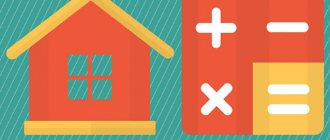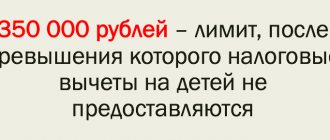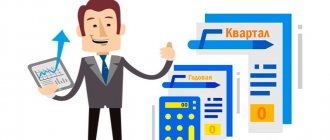For an individual entrepreneur, OSN is the most unfavorable tax regime, since when applying it you have to pay all taxes, submit all reports and keep accounting records. It is worth doing business on the OSN only if the majority of counterparties are VAT payers or the company’s activities are related to the import of goods. You can switch from the OSN to one of the special tax regimes (USN, ENDV, Unified Agricultural Tax, PSN) only by submitting an application to the tax office before December 31 of the current year. The new tax regime can be applied from the beginning of the next one.
Individual entrepreneurs on OSN must pay the following taxes: personal income tax, VAT, personal property tax and other local taxes.
Concept and advantage of OSNO
If, upon registration, an individual entrepreneur did not indicate which taxation system he would use, then he will automatically switch to the general taxation system. If he wants to switch to another taxation system within a year, then he will not be able to do so, since the switch can only be made from the beginning of the calendar year. Individual entrepreneurs very rarely choose this taxation system, since accounting and reporting is very complicated compared to the simplified system.
OSNO is considered the most complex scheme for calculating taxes; accounting is also labor-intensive work. An entrepreneur needs to organize control in such a way as to avoid misunderstandings with tax authorities and penalties. But some entrepreneurs still choose this taxation system.
OSNO's big advantage is VAT. Many large companies are VAT payers and work only with such counterparties. And here the entrepreneur is faced with the choice of either losing a major supplier or buyer, or switching to OSNO. Also, when choosing to pay taxes, the type of activity, the number of employees, and the amount of revenue are taken into account.
Enterprises that choose OSNO:
- Enterprises that work with VAT payers;
- Organizations with large volumes of expenses;
- Unprofitable enterprises, or have a “zero” balance;
The main advantage of OSNO is the payment of personal income tax, so the amount of this tax is determined as a percentage of the difference between the expenses and income of the enterprise. And then the personal income tax turns out to be less than the income tax.
Features and general information about KUDiR
The book has a unified form. It can be maintained either in paper form, entering the necessary data by hand, or electronically.
If the book is kept on a computer, after the expiration of the accounting period it should be printed, the sheets numbered and stitched using thick, coarse thread. The final page is affixed with the individual entrepreneur’s stamp (if any) and signature, and the number of pages is also indicated. The book is then registered with the local tax office.
In the case when a paper version of KUDiR is used, it is registered with the tax office before filling out.
The book includes six sections that reflect all income and expenses of the individual entrepreneur made during the reporting period. It should be noted that sections are filled out depending on the area of work of the individual entrepreneur.
In other words, information needs to be entered only into those KUDiR blocks that are related to the activities of the individual entrepreneur.
Features of OSNO
An individual entrepreneur on OSNO must pay the following taxes:
- Personal income tax 13% – if the individual entrepreneur is a resident and 30% if a non-resident;
- VAT at the rate of 0%, 10%, 18%;
- property tax for individuals at a rate of up to 2%.
- From the moment of registration, the individual entrepreneur does not meet the basic requirements and restrictions on the requirements of the preferential treatment, or over time has ceased to meet them;
- An entrepreneur must be a VAT payer;
- An entrepreneur, by the type of his activity, falls into a preferential category for income tax;
- Due to the lack of knowledge that there are other taxation systems for individual entrepreneurs.
Standardized and non-standardized expenses
At first glance, it seems that since expenses are directly or indirectly related to production, then they are written off to the income tax base in full. This is a misconception; a number of expenses are standardized by the Tax Code of the Russian Federation. You cannot write off an amount that exceeds the standard. Let's look at the basic cost standards.
Advertising expenses. Costs for advertising in the media, for signs and for holding fairs can be completely written off as expenses (clause 4 of Article 264 of the Tax Code of the Russian Federation). Expenses not specified in this paragraph, as well as expenses for the purchase of prizes for the winners of the drawings, are normalized. You can write off as expenses only an amount not exceeding 1% of sales income for the year.
Entertainment expenses. If you often meet with business partners, and especially if they are foreign partners, then the entertainment costs item will be significant. But you can write off as expenses no more than 4% of your labor costs for the reporting period.
Losses. During the delivery or storage of raw materials and supplies, they are subject to physical impact. For example, salt changes weight depending on humidity, liquids can evaporate, etc. Losses from such exposure can be written off as expenses, but only within the limits of natural loss.
Voluntary health insurance. Additional insurance is a good opportunity to attract new employees. But know that you can write off no more than 6% of salary costs.
Expenses that reduce personal income tax from business activities
According to paragraph 2 of Art. 54 of the Tax Code of the Russian Federation, individual entrepreneurs keep records of expenses in the manner determined by the Ministry of Finance of Russia.
Expenses for an entrepreneur include:
- Material costs;
- Expenses are related to labor costs;
- Depreciation of fixed assets that belong to the entrepreneur and are used in business activities.
- Other expenses related to business activities;
- Amounts paid for pension and social insurance;
- Paid taxes, except personal income tax and VAT.
Professional deductions also include contributions to compulsory pension insurance (OPI) and compulsory health insurance (CHI).
Property tax for individuals is included in deductions only when it is used in business activities.
A little about the essence of VAT and deductions
Value added tax is included in the price of goods, works or services sold by the VAT payer. It is paid from the buyer’s pocket, but is part of the proceeds, so the seller must transfer it to the budget.
There is also VAT as part of the cost of goods that an individual entrepreneur purchases for his activities. At the same time, the law gives him the right to deduct this tax, that is, to reduce the amount of VAT payable to the budget by its amount. The deduction is provided only to those entities who pay VAT themselves - it is a mechanism for getting rid of double taxation.
To implement the deduction, an individual entrepreneur must keep tax records . All transactions must be accompanied by the preparation of invoices , and must also be reflected in the books of purchases and sales, the journal of issued and received invoices.
If the individual entrepreneur does not have an invoice issued by the seller, then he will not be able to deduct the tax presented as part of the price of the goods.
Basic information about VAT and its deduction:
How are the expenses of an individual entrepreneur taken into account?
There are certain conditions that must be met in order for expenses to be taken into account when calculating personal income tax. The conditions are:
- Expenses must be paid in full;
- Expenses are associated only with the professional activities of an individual entrepreneur;
- There must be supporting documents, such as invoices, acts, invoices, etc.
There are cases when an entrepreneur cannot document his expenses, then he can take advantage of a professional deduction in the amount of 20% of the amount of income received.
Important. Documentary evidence and the 20% professional deduction cannot be taken into account at the same time.
According to Order of the Ministry of Finance dated August 13, 2002 No. 86n, expenses of an individual entrepreneur can be recognized under the following conditions:
| Recognition criterion | Description |
| Relationship between income and expenses | expenses can be taken into account as deductions for personal income tax only during the period of receipt of income with their help or subsequently |
| Expenses for the purchase of raw materials, materials, goods | These expenses can be included in the professional deduction only when they are written off for production, sales, etc. |
| Depreciation amounts | Amounts of depreciation can be taken into account as a professional deduction only when the property of an individual that is used in business activities must be owned. |
| Seasonal expenses | If the entrepreneur’s activities are seasonal, it is also necessary to observe the principle of the connection between expenses received and income. |
Individual entrepreneur on OSN: tax burden for personal income tax
In this case, personal income tax is paid from any funds received as part of business activities to the cash desk or to the account of the individual entrepreneur. The personal income tax rate for individual entrepreneurs is 13%, as for other individuals.
Unlike VAT, the tax in question is neither incoming nor outgoing. At the same time, when calculating personal income tax, an entrepreneur can use a professional tax deduction and thereby reduce the tax base by the amount of actual business-related expenses (clause 1 of Article 221 of the Tax Code of the Russian Federation).
How significant is the tax burden on individual entrepreneurs paying personal income tax when compared with what characterizes other taxation systems? Let's consider this aspect using the example of a comparison of the special tax system, under which personal income tax is paid, and the simplified tax system.
Example:
Individual entrepreneur A.V. Stepanov, producing components for televisions at his factory, sells them for the amount of 1,000,000 rubles. per year, with production costs of 800,000 rubles. in year. That is, his profit is 200,000 rubles. in year.
If he works under the simplified tax system “income minus expenses”, then he must pay a tax in the amount of 30,000 rubles (15% of 200,000 rubles).
If he works, paying personal income tax taking into account professional deductions, he will already owe the state 26,000 rubles. (13% of RUB 200,000).
If an entrepreneur wishes to work under the simplified tax system “income”, he will pay a tax in the amount of 60,000 rubles. (6% of RUB 1,000,000).
In addition, a regime such as the simplified tax system “income” has a major advantage over the special tax system - it allows individual entrepreneurs to reduce the tax by the amount of mandatory contributions to state funds - the Pension Fund of the Russian Federation, the Social Insurance Fund and the Federal Compulsory Medical Insurance Fund - for themselves and for their employees.
“Non-entrepreneurial” ways to reduce personal income tax
In addition to the professional deduction, an individual entrepreneur can reduce his expenses that arise in the course of business activities through social, standard and property deductions.
Take a concrete example of training costs:
Individual entrepreneur Sokolova T.O. two children.
One child attends a preschool institution, which costs 30,000.00 rubles per year. He also attends an art school - tuition fees are 25,000.00 rubles.
The second child goes to a sports school - tuition fees per year are 54,000.00 rubles.
In connection with production costs, individual entrepreneur Sokolov T.O. wants to claim a deduction for training expenses in the amount of 100,000.00 rubles (50,000.00*2), which will allow him to reduce the tax paid for the year by 13,000.00 rubles (100,000*13)
Note. The total amount of expenses for which an entrepreneur can be provided with a social deduction, with the exception of expenses incurred for expensive treatment and education of children, cannot exceed 120,000 rubles.
VAT for an entrepreneur using “simplified”
Taxpayers under the simplified tax system are exempt from paying VAT. But sometimes, due to ignorance or by meeting the counterparty halfway, such entities can issue invoices and allocate the amount of tax in them. In this case, the tax will be payable even though the individual entrepreneur is not the payer.
In addition, there are other cases when an individual entrepreneur using the simplified tax system is required to pay VAT:
- If he works under a commission agreement , guarantee or other intermediary agreement.
- If he entered into a simple partnership , entered into a trust management agreement.
Moreover, the mentioned legal relations arise only if the entrepreneur, as an object of taxation under the simplified tax system, uses income reduced by the amount of expenses.
An individual entrepreneur using the simplified tax system who pays VAT in connection with agency activities is not considered a payer of this tax. Nevertheless, he is obliged to take into account incoming and outgoing invoices, as well as submit reports to the Federal Tax Service. However, he does not receive the right to deduct input tax.
FAQ
Question No. 1 What is OSNO?
Answer: OSNO is one of the types of taxation system, where an enterprise keeps full accounting records and pays all general taxes.
Question No. 2 What is the advantage of OSNO?
Answer: The main advantage of OSNO is the payment of personal income tax, so the amount of this tax is determined as a percentage of the difference between the expenses and income of the enterprise. And then the personal income tax turns out to be less than the income tax.
Answer: Expenses that reduce personal income tax on OSNO include material expenses, labor costs, depreciation, as well as other expenses that are associated with business activities.
Question No. 4 What conditions must be met in order to reduce personal income tax on OSNO? Answer: The conditions are very simple: payment of all expenses in full, you must provide supporting documents and the expenses are related only to business activities.
Question No. 5 Is it possible to simultaneously use a professional deduction and documentary evidence of expenses to reduce personal income tax?
Answer: Documentary evidence and the 20% professional deduction cannot be taken into account at the same time.
An individual entrepreneur faces certain difficulties when organizing his activities. Among other things, the question arises of which taxation system to choose and what are the individual entrepreneur’s expenses for OSNO. It all depends on the type of activity of the businessman, the amount of his income and the number of employees. Let's take a closer look at what the individual entrepreneur's expenses for OSNO are.
Accounting and reporting of individual entrepreneurs on OSNO
Individual entrepreneurs on OSNO must keep a purchase book and a sales book. This is necessary in order for VAT to be calculated and taken into account.
As for accounting, its maintenance is not mandatory for individual entrepreneurs. Individual entrepreneurs must reflect all their business activities in the book of income and expenses and business transactions. At the same time, individual entrepreneurs must comply with the procedure for accounting for income and expenses and business transactions for individual entrepreneurs, approved by Order of the Ministry of Finance dated August 13, 2002 No. 86 n, as amended on June 19, 2017.
Reporting provided by individual entrepreneurs on OSNO to the tax authorities:
- reporting on “salary taxes” to the Federal Tax Service - quarterly. Since 2016, a monthly report to the Pension Fund of Russia has been added - SZV-M, and since 2021 a single social contribution has been introduced, which combined the reports RSV-1 and 4-FSS. From January 1, 2017, this report must be submitted not to the Pension Fund and Social Insurance Fund, as in 2021, but to the Federal Tax Service. But you will still need to submit a report on contributions for injuries to the Social Insurance Fund;
- from 2021, it is necessary to submit another annual report to the Pension Fund - SZV-STAZH. The deadline for submission is March 1 of the year following the reporting year;
- book of accounting of income and expenses and business transactions of individual entrepreneurs to the tax office - once a year (until April 30);
- declaration 3-NDFL - once a year (until April 30);
- VAT return - every quarter (until the 20th of the next month);
- declaration 2-NDFL – once a year (until March 1 of the next year);
- Declaration 6-NDFL – every quarter (until the last day of the month following the reporting quarter)
- the 4-NDFL declaration with information about the expected profit is submitted only by: newly registered individual entrepreneurs within 5 working days of the month following the month in which the first income was received; existing individual entrepreneurs apply only if their income increases or decreases by 50% from those previously declared.
- land tax declaration to the tax office - once a year (until February 1);
- transport tax declaration to the tax office - once a year (until February 1).
The material has been edited in accordance with changes in the legislation of the Russian Federation 10/13/2019
Advantages of OSNO
If an entrepreneur did not indicate the chosen taxation system during registration, then he automatically becomes a tax payer under the general regime with the ensuing responsibilities. You can switch to the simplified tax system, UTII, unified agricultural tax or patent with OSNO only from the beginning of the calendar year. This system of individual entrepreneurs is chosen very rarely, because in it, unlike the simplified one, the principles of accounting and reporting are more complex and require the application of certain efforts and time.
A businessman can maintain documentation independently, hire an accountant, use the Internet Accounting service, or seek help from a consulting company. In addition to paying taxes, an entrepreneur needs to pay a salary to an accountant or make contributions to a consulting company, which significantly increases costs.
Transition of individual entrepreneurs to OSNO
The transition to the use of OSNO can be voluntary or automatic.
It is possible to voluntarily switch to OSNO only from the beginning of the new calendar year. To do this, you must submit a notification to the Federal Tax Service at the place of registration before January 15 of the year in which you want to apply OSNO. The application form for switching to OSNO depends on which taxation system you used previously.
If you want to switch from UTII to OSNO , you must submit an application in the following form:
- for a legal entity - UTII form-3;
- for individual entrepreneurs - UTII form-4.
The transition from the simplified tax system to the OSNO is carried out according to form 26.2-2. .
To switch from Unified Agricultural Tax to OSNO, you must fill out and submit form N 26.1-3 to the INFS.
An automatic transition to the use of OSNO occurs in the following cases:
- The individual entrepreneur did not submit an application for the application of one of the special tax regimes (USN, UTII, Unified Agricultural Tax, PSN) within 30 days from the date of registration as an individual entrepreneur.
- The individual entrepreneur violated one of the conditions of the Tax Code of the Russian Federation, which allows not to apply OSNO, i.e. lost the right to apply one of the special tax regimes:
- the amount of a taxpayer’s income under the simplified tax system for the entire year cannot exceed 150 million rubles. in 2021;
- the residual value of assets should not be more than 150 million rubles. in 2021;
- the number of employees at the enterprise when using the simplified tax system should be no more than 100 people.
In this case, the notification to switch to OSNO is submitted within 15 days of the month following the quarter in which the violation of the special tax regime occurred.





